DS9
Computer Interface
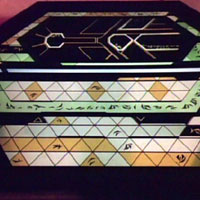
Custodian Controls (TNG-118)
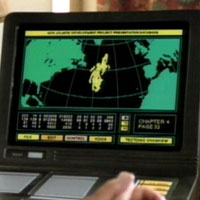
Computer Interface (TNG-178)

Holographic Computer Interface (TNG-107)
![]()
Iconic Display Console (TNG-193)
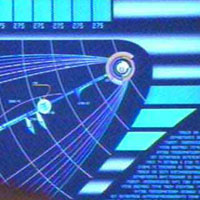
TCARS Interface (VOY-218)

Computer Interface (TNG-178)
Method of interacting with a computer system. The computers aboard the U.S.S. Enterprise NCC-1701 utilized tactile buttons and knobs, as well as motion-sensitive displays and consoles.[1] By the 24th century, touch-sensitive display panels had largely replaced the tactile interfaces,[2] though there were also some uses for holographic interfaces.[3]
References
- 1. “The Cage.” Star Trek, Episode 00. Television. 1965 (Unaired).
- 2. “Encounter at Farpoint.” Star Trek: The Next Generation, Episodes 101-102. Television. 28 September 1987.
- 3. “The Last Outpost.” Star Trek: The Next Generation, Episode 107. Television. 19 October 1987.
Computer chip
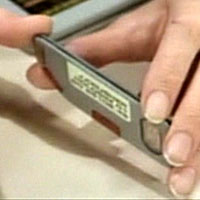
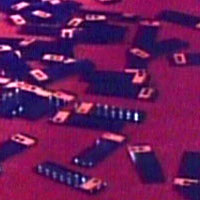
Data storage units.[1] In 2366, Beverly Crusher gave her son Wesley a computer chip with a hologram of his late father, recorded when he was an infant.[2]
References
Computer
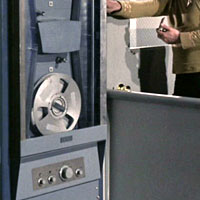
Data storage, retreival and computational device. Early computers on Earth were quite large and used magnetic tape to store information.[1]
References
Chronometer

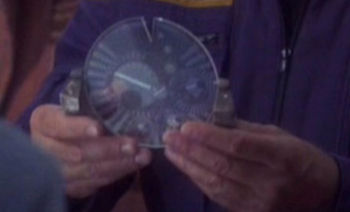
Timekeeping device. In 2265, the chronometers on the U.S.S. Enterprise NCC-1701 unexpectedly ran backwards while escaping the destruction of the planet Psi 2000, an initial indication that the ship was actually traveling backward through time.[1] In 2151, Jonathan Archer was presented with the gift of a clock by Prah Mantoos.[2]
References
Autodestruct

System designed to scuttle a ship upon the authorization of senior officers. In 2285, Admiral Kirk used the autodestruct system to prevent the U.S.S. Enterprise NCC-1701 from falling into Klingon hands, taking most of the crew of a Bird of Prey with it in the process.[1] Captain Jean-Luc Picard used the autodestruct system on the U.S.S. Enterprise NCC-1701-D on several occasions, disabling it prior to detonation each time; notably, when the ship was captured by Bynars in 2364.[2]
References
Chess, 3D


Three-dimensional version of the ancient Human game of chess. Captain Kirk and Commander Spock often played together aboard the U.S.S. Enterprise NCC-1701.[1] The game was also popular aboard the U.S.S. Enterprise NCC-1701-D more than a century later.[2]
References
Ancient West

Holoprogram created by Reg Barclay and Alexander Rozhenko in 2369, set in the town of Bozeman, Montana during the late 19th century. Unfortunately, a computer malfunction during the first time the program was run caused several of the characters to be replaced with the image of Lieutenant Commander Data.[1]
References
Alice in Wonderland


Children’s story, written by Lewis Carroll. The U.S.S. Enterprise NCC-1701 encountered a recreation of Alice and the White Rabbit, characters from the story, on what was dubbed an “Amusement Park” Planet in 2266.[1]
References
Hypospray
Common medical implement used to deliver medication to a patient subcutaneously by using an extremely fine, high-pressure aerosuspension delivery system. Hypospray technology was more hygienic in that it eliminated the need for a needle to physically penetrate the skin.[1]
References
Dermal Regenerator
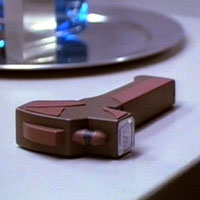
Dermal Regenerator (TNG-197)
Medical device that regrew damaged, dead, or missing tissue. The Trill ambassador, Odan, used a dermal regenerator on himself in an attempt to treat severe tissue damage prior to his host’s death in 2367.[1]
References
- 1. “The Host.” Star Trek: The Next Generation, Episode 197. Television. 13 May 1991.
Categories
- Animated Series (60)
- Articles (28)
- Books (447)
- Cast & Crew (79)
- Comics (22)
- DS9 (328)
- Early Voyages (125)
- Education (5)
- Enterprise (373)
- Excelsior (36)
- Food (19)
- Games (223)
- Klingon (70)
- Library (1,543)
- Logs (593)
- Lost Era (55)
- Medicine (18)
- Merrimac (1)
- Mirror (35)
- Miscellaneous (13)
- New Frontier (54)
- Next Generation (635)
- Original Series (681)
- Personnel (436)
- Places (369)
- Politics (12)
- Recreation (10)
- SCE (41)
- Science (1)
- Shatnerverse (9)
- Ships (455)
- Site Updates (98)
- Starfleet Academy (86)
- Stargazer (42)
- STO (61)
- Technology (45)
- Titan (59)
- To Boldly Go (1)
- TV/Film (214)
- Uncategorized (4)
- Vanguard (76)
- Voyager (236)
- Weapons (27)
- Xenology (54)